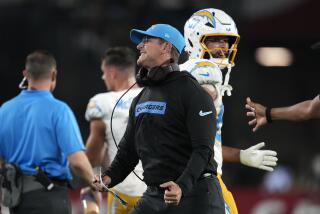FEELING THE HEAT : Nothing Much Cool About Phoenix Except for Its Feeling Toward NFL Cardinals
SAN DIEGO — There is a popular assumption that the honeymoon between the transplanted football Cardinals and the people of Phoenix is over.
This is wrong. There never was a honeymoon in the first place.
When Cardinal owner Bill Bidwill brought his team from St. Louis before the 1988 season, it seemed that his first move was to alienate his new customers. The Cardinals’ price-gouging and general front-office ineptitude combined to turn off fans before their imported heroes had played a game.
A year later, the animosity has died down somewhat, but the damage isn’t close to being repaired. Cardinal season-ticket sales have plunged 31% from 55,000 to 37,900, and a crowd of only 40,000 to 45,000 is expected Sunday for their home opener against the Chargers.
Once it became obvious that an adversary relationship had been established, Phoenix sports writers began bombarding Bidwill in print.
Joe Gilmartin, veteran columnist of the Phoenix Gazette, summed up the situation with a remark after Bidwill underwent gall bladder surgery.
Wrote Gilmartin: “The bladder was removed, but the gall remained.”
This wasn’t the first time the Cardinals had packed their belongings and left town. They were originally based in Chicago but, tired of playing second fiddle to the immensely popular Bears, they moved to St. Louis after the 1959 season.
The Cardinals and Bears are the only surviving charter members of the National Football League, which was founded in 1920 as the American Professional Football Assn. Since the Bears began as the Decatur Staleys, the Cardinals are the only team to carry the same nickname throughout the league’s 70 seasons.
Still, tradition hasn’t helped the Cardinals. Even after escaping the shadow of the Bears, they failed to catch on in St. Louis. They drew only 23,336 per game in their first season there, reached their all-time high at 48,084 in 1981 and fell to 27,821 in 1987. Their largest crowd in 28 seasons at Busch Memorial Stadium was 51,010 for the Rams in 1984.
Considering the franchise’s long history of frustration, Bidwill might have been expected to shower the folks of Phoenix with kindness. He finally had found a city that was hungry for an NFL team, one with a stadium big enough for him to turn a profit. The Cardinals arranged to play in Arizona State’s Sun Devil Stadium, which has a seating capacity of 72,000.
But all these positive factors did for Bidwill was lead to greed. He set up an average ticket price of $38, the highest in the NFL by a whopping $12. When the fans rebelled, they had to air their complaints by mail, because the Cardinals didn’t list their telephone number for three months.
Bidwill was even hindered by a ticket situation that was beyond his control. Under a previous agreement with Arizona State, season-ticket holders of the Arizona Outlaws of the defunct United States Football League had first call on season tickets of any NFL team that would occupy Sun Devil Stadium. There were only 15,000 of those, but ASU had 55,000 for college football, and they held second priority.
The result was that any new Phoenix fans had to pay exorbitant prices for bad seats.
“It was a public relations blunder of monumental proportions,” Gilmartin said in a phone conversation. “The Cardinals as much as said, ‘If you can’t afford it, sorry. Just get your money out.’
“After the initial reaction, they compounded their mistake. They had an opportunity to backtrack and roll back the prices. Sometimes you can turn a negative into a positive. But they didn’t budge, and matters only got worse.
“It was almost as though they called the people in the front office together and said, ‘Everybody likes us. How can we turn that around in an instant?’ The hostility was incredible.”
In spite of all this, the Cardinals drew a franchise-record 472,937 fans last year, a 59,117 average. They sold out one game, against Dallas.
The ticket scale has been restructured for the Cardinals’ second season in Phoenix, but the average price has dropped only to $36. Bidwill will more than make up this meager difference with revenue from the stadium’s 60 new luxury boxes, which rent for $60,000 each per year. The Cardinals will get $2.4 million of the $3.6 million, ASU the remainder.
“Actually, I’ve kind of praised the Cardinals lately,” Gilmartin said. “I’ve suggested that Bidwill may be the league’s most improved owner. The team had a good draft for a change, made some positive moves in the front office and signed 11 Plan B free agents, including (quarterback) Gary Hogeboom.
“The trouble is, Bidwill had too much ground to make up.”
Gilmartin added that the Cardinals face the handicap of sharing the stadium with a college team that has made a habit of winning.
“The people here aren’t bumpkins,” Gilmartin said. “Having watched ASU over the years, they believe a 10-1 record on up is OK.”
The Cardinals have started out 2-1 but figure to finish under .500 in the tough NFC East. They were 7-9 last year, and since then have lost quarterback Neil Lomax with what may be a career-ending hip injury.
From the start, Bidwill has declined to discuss the controversy swirling around him. Because he is inaccessible by phone, Terry Bledsoe, vice president of communications, served as the Cardinals’ spokesman.
“Obviously, we’re concerned about the decrease in season tickets,” Bledsoe said. “We expected it to be down, but not this much. We’ve got to build it up, but we’ve got to win to do it.
“There are any number of valid reasons for the problem, and part of it is nothing more than the economy in Phoenix. By the year 2000, this will be the seventh or eighth largest city in the country, but we’re in a recession right now. The housing market is in a bad slump.”
The excuse used most often is the intense heat in Phoenix. There already have been 125 days this year with the temperature above 100, and the heat wave isn’t over yet. Because of this, the NFL scheduled the Cardinals’ first three games away from home.
“We’ve had 90% (season-ticket) renewals on the shaded side of the stadium,” Bledsoe said. “Virtually all the cancellations have been on the other side.
“Personally, though, I think the heat will be overcome when we win. The people here are outside more than they are anywhere other than a place like San Diego. If they’re not at the game, they’re playing golf or doing something else outdoors.
“People live here because of the weather. They jog, ride bikes, things like that. If they want to do it, they do it. People in Green Bay sit outside in winter weather. You can say they’re insane to do it, but they do it.”
In case the Cardinals don’t win often enough to beat the heat, one solution being considered might be called outdoor air conditioning.
“It sprays fine mist around the stadium,” Bledsoe said, “and the mist evaporates as it descends, so the fans get cooled off without getting wet.”
Playing at night would help, but the Cardinals can do that only when television dictates, and that won’t happen this year. The networks want winners on their prime-time telecasts. Charger Coach Dan Henning suggested the other day that the Cardinals start games at 4 p.m. instead of 1, but TV commitments make that impossible.
“If we were in the East, we would have the option of playing at 1 or 4,” Bledsoe said. “Here, we have to play at either 10 or 1, or 11 or 2 when the rest of the country goes off daylight time. We’re on standard time all-year around.
“Obviously, we don’t want to start games in the morning. One hope we have is that ESPN may have 16 Sunday night games under the new TV contract next year instead of eight. Maybe we could get a couple of early-season games on that schedule.”
In any case, the road ahead for Bidwill and the Cardinals will go uphill. Heat or no heat, they have many fences to mend.
As Gilmartin put it, “When you start out by kicking people in the fannies and then try to put those fannies in pews, you’re tackling a tough task.”
More to Read
Go beyond the scoreboard
Get the latest on L.A.'s teams in the daily Sports Report newsletter.
You may occasionally receive promotional content from the Los Angeles Times.










